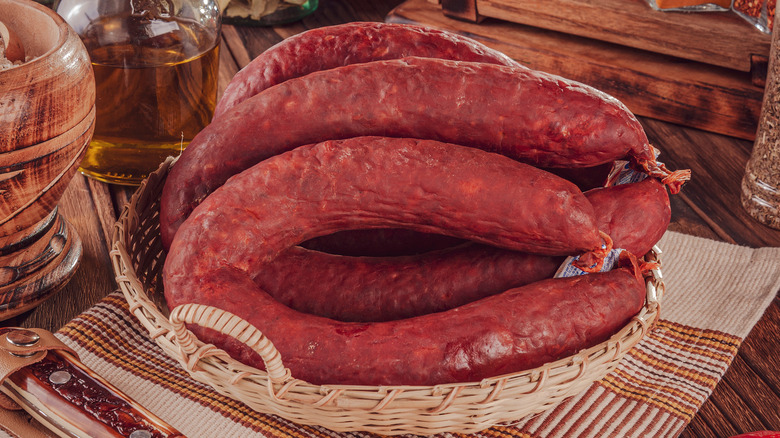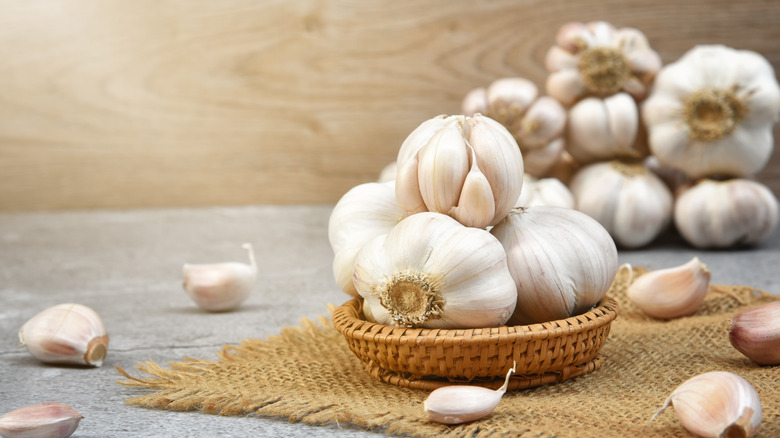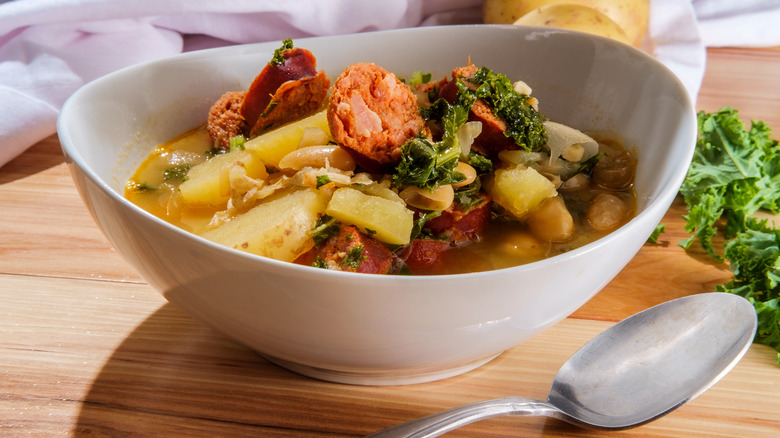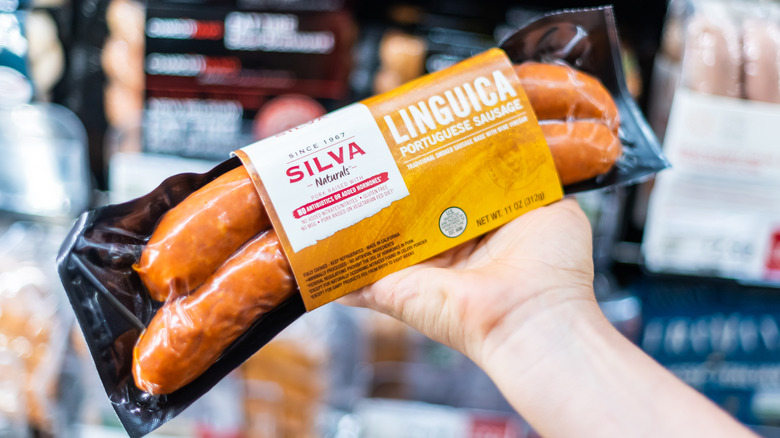What Is Linguica And What Does It Taste Like?
Portugal has contributed more than its share of tasty dishes (that are a mouthful to say) to the international culinary scene. From bacalhau, which is a dried and salted codfish (and the national dish, according to Expatica) to everyday comfort fare like caldo verde, a hearty vegetable and sausage soup, the country offers a rich variety of dishes for visitors to experience. Linguiça, or linguisa (pronounced ling-gwee-suh, per Dictionary.com), is one of those appetizing Portuguese delights worth exploring.
Linguiça has a long history, one that may even go all the way back to the Moors, who invaded the Iberian peninsula long before Portugal even existed, according to New Bedford History. Luckily, today you can find the sausage stateside, because families that immigrated from Portugal brought their delicious recipes with them, according to the outlet. If you are at all put out by the name, don't be! Though "lingua" does mean tongue in Portuguese, according to On The Gas, it refers to the sausage's tongue-like shape and not its ingredients.
How is linguiça made?
Delighted Cooking explains that linguiça is made from pork butt, which confusingly enough, is a cut taken from the pig's shoulder and part of the upper arm. The pork butt is cut into pieces and mixed with spices.
At this point, sometimes a salt and vinegar brine is added to the meat mixture before stuffing it into casings. Alternatively, the mixture can be stuffed into casings and the sausages can be brined overnight. The brine "mellows" the flavor of the sausage.
Linguiça can be consumed immediately after brining, but more often it is tempered with a smoking process that makes it flavorful, tender, and more durable. Usually, the sausage is refrigerated or frozen and cooked again before being eaten or added to soups or sandwiches.
What does linguiça taste like?
Are you a big fan of garlic? According to Delighted Cooking, linguiça is a sausage known for its garlicky, mildly spicy flavor. The pork butt from which it is made gives it a lean, meaty taste, and it's typically spiced with seasonings like oregano, paprika, garlic, pepper, cumin, and sometimes even cinnamon. Moreover, smoking the meat after it's been brined makes it flavorful, tender, and more durable.
If you're thinking this sausage sounds a lot like chourico, there's a reason: the two sausages are linked in more ways than one. According to Fun 107, a radio station serving the areas of Fall River and New Bedford, Massachusetts, where there is a Portuguese influence on culture and food, both are Portuguese pork sausages. Some find the taste of Linguiça similar to pepperoni, while the redder chourico is made with dried smoked peppers and "has some bite to it."
What dishes can you make with linguiça?
Linguiça is used in a variety of Portuguese dishes, like caldo verde. According to Cuisine At Home, this "green soup" is made of potatoes, kale, and Portuguese sausage like linguiça. Another traditional use for linguiça is adding the sausage to franceshina, a Portuguese sandwich. The tasty sandwich is packed with cured ham, linguiça, and steak, oven-baked, and covered with melted cheese, sauce, and sometimes even an egg. And just when you think things couldn't possibly get better, the sandwich is often served with French fries and beer!
On the Gas' Portuguese Hash recipe combines linguiça sausage with onions, potatoes, and garbanzo beans in a skillet to create a mouthwatering dish that is finished off with four eggs cracked and cooked on top. Talk about eating breakfast like a king!
Another fantastic way to use linguiça is as a pizza topping. Of course, you can just use linguiça in place of pepperoni in any of your favorite pizza recipes, or you could take your pie to bonus level heights with a recipe like Linguiça Potato Pesto Pizza from Everyday Portuguese. This recipe had us at pesto, but we also swooned at the sound of mozzarella or provolone cheese combined with potatoes and red pepper flakes.
Where can you buy linguiça?
If you're on the East Coast, then you might have some luck finding linguiça under the Gaspar's label. According to its site, the Massachusetts-based Gaspar Sausage Company Inc. is the "largest manufacturer of Portuguese sausage in the country." Their products are located in supermarket chains in New England, as well as in parts of New York, Virginia, Pennsylvania, Florida, and Bermuda. Other Massachusetts sausage companies include Mello's Chourico and Amaral's, each with their own legions of sausage devotees.
According to On the Gas, linguiça has also become a big part of Central Valley California's culinary scene thanks to Manuel Martins of Silva Sausage. Martins started the company in 1967, and his linguiça became popular with the Portuguese community in San Jose. Today Silva Sausage products are available in several states on the West Coast and beyond (via the Silva Sausage website). Depending on where you live, you might find Silva brand linguiça at your local Costco, Safeway, Whole Foods, or Walmart.
New England ballparks have also had a history of serving the sausage (via the Sun Sentinel). Snagging a linguiça roll while you take in a game sounds like the best way to enjoy the sausage, if your team is winning, of course.




